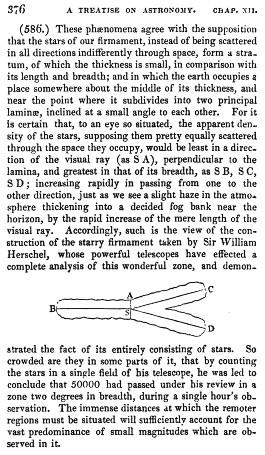In the eighteenth and at the beginning of the nineteenth centuries astronomy actually consisted in the studies of motions of celestial bodies from the Solar System and creating more and more accurate and extensive catalogues of stars.
At the turn of these centuries new areas of studies were indicated by William Herschel, who conducted systematic observations of nebular objects, star clusters, and double stars and tried to comprehend how they evolve. It was thanks to Herschel that the first evidence of the applicability of Newton’s mechanics outside the Solar system was discovered in 1803. His observations showed that double stars in some systems revolve around each other under the influence of gravity. However, physics in the nineteenth century changed the face of astronomy in yet another way, namely by the development of spectral analysis.
It was Joseph Fraunhofer (1787–1826) who noticed several hundred absorption lines in the solar spectrum for the first time. In 1859 Robert Bunsen (1811–1899) and Gustav Kirchhoff (1824–1887) identified these lines and ascribed them to the known chemical elements. This way human kind became able to study the chemical composition of the universe.
 The engraving featured in John Herschel's work 'A Treatise on Astronomy', London 1833
The engraving featured in John Herschel's work 'A Treatise on Astronomy', London 1833
In the first half of the nineteenth century the beginning of astronomical photography could also be observed, the first subject of which was the Sun, but in 1870s photographs of spectrums of several bright stars were obtained. And thus it became evident that the close marriage of large instruments, such as refractors and reflectors, and photographic camera and spectrographs was unavoidable. This enabled systematic study of stellar spectra and consequently the drawing of conclusions on stellar composition, temperature and spatial velocity.
It was thanks to the spectroscope that William Huggins (1824–1910) in the 1860s was able to answer one of the crucial questions of astronomy from the time of Herschel, namely whether the nebulae are clusters of gas or perhaps very distant groups of stars, the light of which forms the mist. Spectral analysis gave a clear answer: there are two kinds of nebulae – gaseous and stellar. The collection of objects saturating the universe was becoming increasingly interesting. However, it was still not known what this universe was and what were its boundaries.
It was William Herschel who on the basis of counts of stars in various areas of the sky attempted to determine the boundaries of the Milky Way perceived as the system of stars, in which the Sun is located. We know today that he obtained a wrong image of the reality, but subsequent attempts made till the end of the nineteenth century were unsuccessful as well. All in all, astronomers agreed that the Sun is situated in some sort of flat discus formed by stars that has a diameter of up to ten times its thickness. In the second half of the nineteenth century another problem appeared, for there was a growing number of spiral nebulae discovered (the first one was noticed in 1845). Should they be regarded as stellar systems similar to the Milky Way or perhaps considered to be nebulae situated within it and constitute planetary systems in statu nascendi?
The majority of astronomers were more inclined to the second solution. They became reassured that they were right by the flash of a star that took place in 1885 in the Andromeda Nebula. Within a few days the star reached the luminosity that was almost equal to the brightness of the whole nebula. The physicists of that time did not know the mechanism that would cause a star to brighten so much, it was therefore assumed that the nebula could not consist of millions of other stars and be a separate system on its own. It seemed more prudent to assume that they were dealing with a lonely star forcing its way through a gaseous cloud nearby.
Further reading
- The Cambridge Concise History of Astronomy, ed. by M. Hoskin (Cambridge, 1999).
- J. Crowe, Modern Theories of the Universe from Herschel to Hubble (New York, 1994).
- B. Hearnshaw, The Analysis of Starlight: One Hundred and Fifty Years of Astronomical Spectroscopy (Cambridge, 1986).
 English (United Kingdom)
English (United Kingdom)  Polski (PL)
Polski (PL) 





